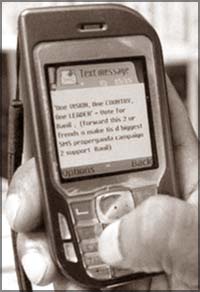Reaching the ‘unbanked’ by mobile phone
Lionel Wijesiri
Access to banking services are still not equally distributed in our
country, says a leading banker, Chandula Abeywickrema. According to him,
70 percent of the country’s population still lives without any direct
access to formal financial system.
The most serious revelation is that out of the 1,100 bank branches
run by the six leading banks, 50 percent are located in the Western
Province where a branch is available for every 10,000 people.
In other areas, the figure can go up to 25,000 people per branch. In
short, Sri Lanka’s poor, many of who work as agricultural and unskilled
or semi-skilled wage earners or micro-entrepreneurs, are excluded from
the formal financial system.
Banking services
|

Access to banking services through mobile phone |
To counter this issue of unfair accessibility, modern analysts agree
that the mobile handset is paving the way to becoming the primary
channel for distributing banking services to the unbanked.
A smart mobile banking model radically alters the economics of
serving this emerging rural segment. For example, with the new
technology, a grandmother in rural area can receive money from her son,
working hundreds of miles away, with the beep of her cell phone. A
housewife can buy groceries with a few punches of keys. Not a coin need
change hands.
Experiences
This high-tech solution designed to help poor people who never have
had access to banks, cash machines, or credit cards, are now implemented
successfully in a host of developing countries. It is another example of
using digital technology to fast forward development in remote areas.
One classic example of success of cell phone banking is South Africa.
The system uses a patented security mechanism and requires only a mobile
phone and a government-issued identity number to subscribe. There are no
monthly charges, only fees for each transaction. Each account is linked
to a nationwide ATM card that can be used to deposit and withdraw money.
The Indian experience is also noteworthy. I have seen how mobile
banking system operates in India. I remember speaking to Ram Joth Kumar,
a fruit vendor at Purvanchal region of Uttar Pradesh.
He does not go to the bank, 20 km away, when he wants to transact
business with it. Instead, it comes to him, in the form of Ashmit Saha,
a young man equipped with the tools of mobile banking. Saha even speaks
Bhojpuri, the one language with which Ram is comfortable.
Across India, banks are using ‘correspondents,’ or people who
effectively serve as extensions of branches, in an effort to reach out
to clients who do not have access to banks and banking services. One
bank is using dabbawallas, the men who ferry hot lunches to office-goers
across the city, as its correspondents.
Benefits
Apart from increasing reach, the correspondent model reduces a bank’s
transaction costs. Banks pay correspondents a nominal salary and a
commission on top of this; the magnitude of the commission is a function
of the number of transactions conducted, customers acquired, or deposits
mobilized by the correspondent.
Mobile banking could be another area in which the developing world
can leapfrog the developed world. It is far easier to bolster rural cell
coverage than it is to build countless bank branches to serve millions
of people tucked away in remote areas.
Mobile carriers
Yet, hurdles remain for wider use of mobile banking. Mobile carriers
must have broad enough coverage to connect urban and rural users, as
many remittances come from urban migrants sending money back to their
family villages.
It can also be hard to convince villagers, many of whom are new to
the concept of banking, that a virtual bank is a safe place to stash
their hard-earned cash. However, once their initial fears are dispelled,
easier access to banking will encourage rural people to save more, and
to put their saving to better use.
In Sri Lanka, nearly 9 million now have cell phones; that is,
technically half of our population uses mobile phones. Surveys reveal
that the phones are well distributed among the rural sector and growing
each year. This means that the technology is already in place for the
introduction of mobile phone banking and what remains is action to serve
this deserving and growing market. |



